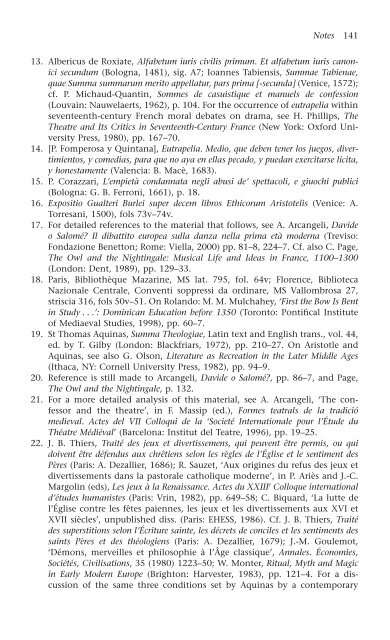Recreation in the Renaissance
Recreation in the Renaissance
Recreation in the Renaissance
- No tags were found...
You also want an ePaper? Increase the reach of your titles
YUMPU automatically turns print PDFs into web optimized ePapers that Google loves.
Notes 141<br />
13. Albericus de Roxiate, Alfabetum iuris civilis primum. Et alfabetum iuris canonici<br />
secundum (Bologna, 1481), sig. A7; Ioannes Tabiensis, Summae Tabienae,<br />
quae Summa summarum merito appellatur, pars prima [-secunda] (Venice, 1572);<br />
cf. P. Michaud-Quant<strong>in</strong>, Sommes de casuistique et manuels de confession<br />
(Louva<strong>in</strong>: Nauwelaerts, 1962), p. 104. For <strong>the</strong> occurrence of eutrapelia with<strong>in</strong><br />
seventeenth-century French moral debates on drama, see H. Phillips, The<br />
Theatre and Its Critics <strong>in</strong> Seventeenth-Century France (New York: Oxford University<br />
Press, 1980), pp. 167–70.<br />
14. [P. Fomperosa y Qu<strong>in</strong>tana], Eutrapelia. Medio, que deben tener los juegos, divertimientos,<br />
y comedias, para que no aya en ellas pecado, y puedan exercitarse licita,<br />
y honestamente (Valencia: B. Macè, 1683).<br />
15. P. Corazzari, L’empietà condannata negli abusi de’ spettacoli, e giuochi publici<br />
(Bologna: G. B. Ferroni, 1661), p. 18.<br />
16. Expositio Gualteri Burlei super decem libros Ethicorum Aristotelis (Venice: A.<br />
Torresani, 1500), fols 73v–74v.<br />
17. For detailed references to <strong>the</strong> material that follows, see A. Arcangeli, Davide<br />
o Salomé Il dibattito europea sulla danza nella prima età moderna (Treviso:<br />
Fondazione Benetton; Rome: Viella, 2000) pp. 81–8, 224–7. Cf. also C. Page,<br />
The Owl and <strong>the</strong> Night<strong>in</strong>gale: Musical Life and Ideas <strong>in</strong> France, 1100–1300<br />
(London: Dent, 1989), pp. 129–33.<br />
18. Paris, Bibliothèque Mazar<strong>in</strong>e, MS lat. 795, fol. 64v; Florence, Biblioteca<br />
Nazionale Centrale, Conventi soppressi da ord<strong>in</strong>are, MS Vallombrosa 27,<br />
striscia 316, fols 50v–51. On Rolando: M. M. Mulchahey, ‘First <strong>the</strong> Bow Is Bent<br />
<strong>in</strong> Study . . .’: Dom<strong>in</strong>ican Education before 1350 (Toronto: Pontifical Institute<br />
of Mediaeval Studies, 1998), pp. 60–7.<br />
19. St Thomas Aqu<strong>in</strong>as, Summa Theologiae, Lat<strong>in</strong> text and English trans., vol. 44,<br />
ed. by T. Gilby (London: Blackfriars, 1972), pp. 210–27. On Aristotle and<br />
Aqu<strong>in</strong>as, see also G. Olson, Literature as <strong>Recreation</strong> <strong>in</strong> <strong>the</strong> Later Middle Ages<br />
(Ithaca, NY: Cornell University Press, 1982), pp. 94–9.<br />
20. Reference is still made to Arcangeli, Davide o Salomé, pp. 86–7, and Page,<br />
The Owl and <strong>the</strong> Night<strong>in</strong>gale, p. 132.<br />
21. For a more detailed analysis of this material, see A. Arcangeli, ‘The confessor<br />
and <strong>the</strong> <strong>the</strong>atre’, <strong>in</strong> F. Massip (ed.), Formes teatrals de la tradició<br />
medieval. Actes del VII Colloqui de la ‘Societé Internationale pour l’Étude du<br />
Théatre Médiéval’ (Barcelona: Institut del Teatre, 1996), pp. 19–25.<br />
22. J. B. Thiers, Traité des jeux et divertissemens, qui peuvent être permis, ou qui<br />
doivent être défendus aux chrêtiens selon les règles de l’Église et le sentiment des<br />
Pères (Paris: A. Dezallier, 1686); R. Sauzet, ‘Aux orig<strong>in</strong>es du refus des jeux et<br />
divertissements dans la pastorale catholique moderne’, <strong>in</strong> P. Ariès and J.-C.<br />
Margol<strong>in</strong> (eds), Les jeux à la <strong>Renaissance</strong>. Actes du XXIII e Colloque <strong>in</strong>ternational<br />
d’études humanistes (Paris: Vr<strong>in</strong>, 1982), pp. 649–58; C. Biquard, ‘La lutte de<br />
l’Église contre les fêtes paiennes, les jeux et les divertissements aux XVI et<br />
XVII siècles’, unpublished diss. (Paris: EHESS, 1986). Cf. J. B. Thiers, Traité<br />
des superstitions selon l’Écriture sa<strong>in</strong>te, les décrets de conciles et les sentiments des<br />
sa<strong>in</strong>ts Pères et des théologiens (Paris: A. Dezallier, 1679); J.-M. Goulemot,<br />
‘Démons, merveilles et philosophie à l’Âge classique’, Annales. Économies,<br />
Sociétés, Civilisations, 35 (1980) 1223–50; W. Monter, Ritual, Myth and Magic<br />
<strong>in</strong> Early Modern Europe (Brighton: Harvester, 1983), pp. 121–4. For a discussion<br />
of <strong>the</strong> same three conditions set by Aqu<strong>in</strong>as by a contemporary










